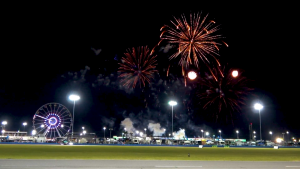Transcript
In January, while most of the country is in the depths of winter, 45 minutes Northeast of Orlando in the small beach town of Daytona, their thoughts are not of clearing off the sidewalk, their thoughts are of speed!
Every January, the eyes of the motorsport’s world turn to Florida for the beginning of Speedweeks, and the first major automobile race of the year in the United States – The Rolex 24 at Daytona.
A grueling endurance race twice around the clock, the Rolex 24-hour race is the first of three events known as the Triple Crown of endurance racing – the others being the 12 hours at Sebring and Vingt Quatre Heures du Mans, or the 24 Hours of Le Mans.
Join me as we take a look at what could be the fastest weekend of your life!
It’s race day in Florida.
Green flag for the Rolex 24 at Daytona is still hours away, but there is much to do. Teams run their cars through one final technical inspection to ensure they are race ready.
Even though it’s early, thousands of fans have started pouring in. They line up early to get an autograph from the famous drivers that will be racing today. Soon that population of fans will grow to be the size of a medium city in Florida. Elite drivers from the world’s biggest racing series come here – Formula 1, Indy Car and Sports Car drivers – all hoping to be one of a small group called Rolex 24 champions.
The only thing standing in the way, is an arena with nearly 50 teams on the field at the same time, and 24 hours to get the job done.
What makes the Rolex 24 at Daytona and indeed all SportsCar racing different from other elite forms of motorsports, is that, unlike Formula 1 or IndyCar which races with one class of car on the track, endurance SportsCar racing has many classes. For the Rolex 24 – there are two styles and four different classes of cars that race at the same time.
The first is GT Daytona (or GTD) this class consists of cars from leading manufacturers such as Acura, Audi, BMW, Ferrari, Lamborghini, Lexus, McLaren, Mercedes-AMG, and Porsche. This Pro-Am class of cars are enhanced, but not defined by the technology they utilize.
The second is GT Le Mans (or GTLM). These cars apply the same technical regulations as the 24 Hours of Le Mans and are the most elite and fastest of the GT class cars on the track. They are engineered to extract the maximum performance possible – the true proving ground for leading manufacturers such as BMW, Corvette, Ferrari, Ford, and Porsche.
Next up is Le Mans Prototype 2 (or LMP2). Developed by four approved constructors, LMP2 cars are eligible to compete in other global series such as the FIA World Endurance Championship, which includes the prestigious 24 Hours of Le Mans.
The leading class is Daytona Prototype International (or DPi) – The fastest and most technologically advanced sports cars in North America. This class is specifically designed and engineered for the racetrack powered by engines from mainstream automotive manufacturers like Acura, Cadillac, Mazda, and Nissan.
Day turns into night, and the long hard hours of driving in the Rolex 24 at Daytona have begun. Each team consists of at least 2 drivers who pilot the car in defined stints of racing – a blur of breakneck speed interrupted mercifully by periodic pit stops, the only time a driver will have to come up for air. For the fans who camp out at the track – the night is like a carnival. The race becomes a myriad of sound and lights coming from the cars, the midway and a spectacular firework display that lights up the Daytona sky.
The nighttime hours comprise the longest portion of the Rolex 24. As dawn approaches drivers know the time is short for them to make their move to win the race and be crowned a champion.
The final two hours of the Rolex 24 at Daytona are the most intense for both driver and fan. It is during this critical period that teams burdened with fatigue and sleeplessness must be fully alert. Any small mistake can cost the team not only the championship but can put both car and driver in peril. The Rolex 24 race is not measured in laps, but in time. Every minute both driver and machine are running at the red line. Often one or the other will give out.
But for those who persevere. Neither lack of sleep nor the weight of exhaustion can overcome the thrill of passing the checkered flag first – and to be called forevermore – a Rolex 24 champion.
Rolex 24 at Daytona


